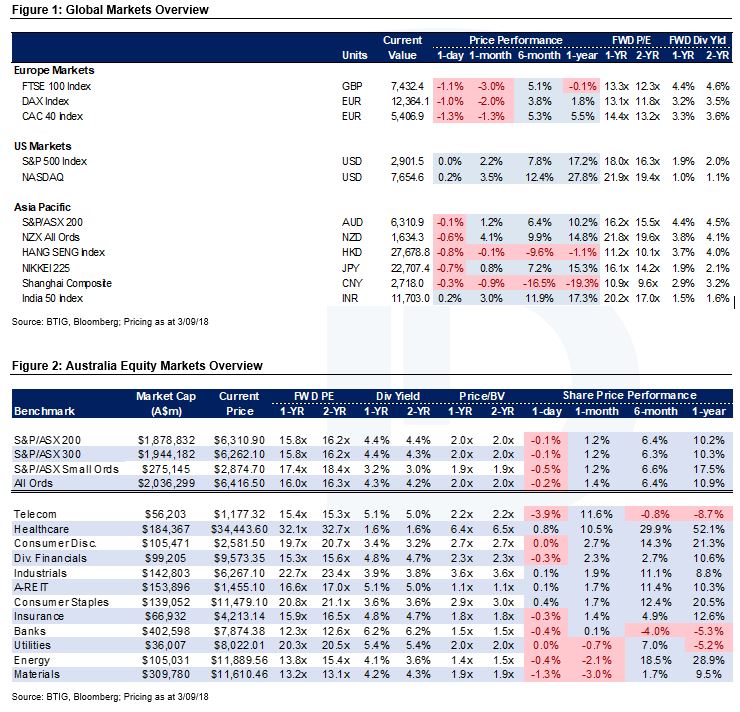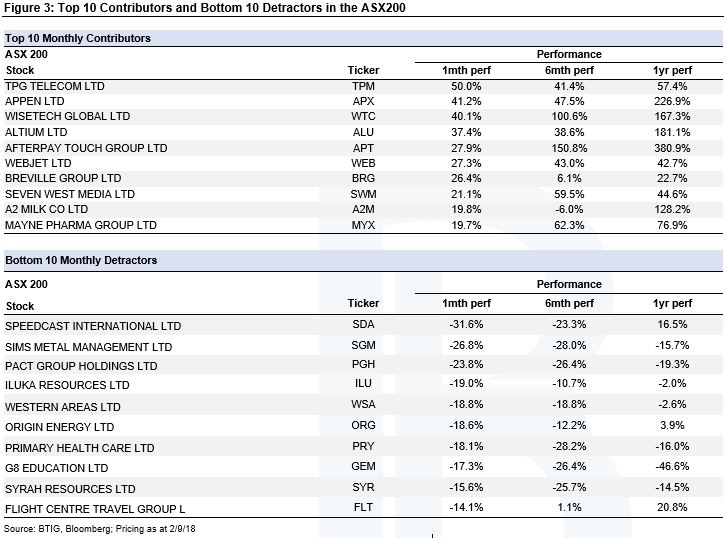Summary: August Reporting Season 2018 – The Key Themes
Summary: August Reporting Season Review - Key Themes
The month of August 2018 was Australian corporate reporting season whereby Australian companies announced their results to date, so investors can assess the progress of both management teams and the operations of those companies. August 2018 saw the ASX200 perform strongly relative to global markets, increasing +1.2% (behind the U.S S&P 500 and NASDAQ which increased +2.2% and +3.5% respectively, whilst European and Chinese markets were laggards).
Current ASX 200 multiples and valuations. The ASX 200 currently trades on ~16x one year forward price to earnings, ~4.4% dividend yield, 2.0x price to book, 12.3% return on equity, 5.4x net debt to EBITDA.
Contributors and Detractors to ASX200 performance. From figures 2 and 3, Telcos was up +11.6%, driven by TPG Telecom (TPM), up +50% following the announcement of a potential merger with Vodafone Hutchison. Healthcare was up +10.5% on strong results from CSL Ltd (CSL) despite disappointing results from Ramsay Healthcare (RHC) and Primary Healthcare (PRY). The materials sector led losses with Syrah Resources (SYR), Western Areas (WSA) and Iluka Resources featuring in the bottom 10 performers, down -15.6%, -18.6% and -19.0% respectively, in the month.
Key themes of August 2018 reporting season. Three major themes were evident; they include:
- Consumer remains constrained with leverage: Results season reaffirmed softness in housing conditions with pressured sales momentum for real estate developers, moderating hardware sales and depressed secondary auction market conditions. Retail REITs saw low sales growth of ~2.0% across consumer specialty stores, household goods etc. JB HiFi (JBH) reported softer sales in its Good Guys division and Harvey Norman (HVN) reported weaker year to date Australian like for like sales, down -1.1%. Health Insurance results (from nib Holdings, NHF and Medibank Private, MPL) highlighted pressure on the consumer, leading to continuous downgrade of policies and discussions on health insurance affordability. Banks like Westpac (WBC) and Suncorp (SUN) increasing variable interest rates on mortgages by 14bps and 17bps respectively does not help the consumer going forward. General Insurance companies reported motor insurance pricing rising on average +5-6% and home insurance pricing up by +3-4%. Alternative financing’ models like Afterpay Touch (APT) reported strong growth, particularly with the younger demographic.
- Capital Management remains a theme… While large capital returns via share buybacks or higher dividend payments demonstrate stronger balance sheets in both regulated and traditional industries, in some instances they may also suggest a lack of growth opportunities for companies both domestically and offshore. Some of the larger capital initiatives announced included:
(1) Rio Tinto (RIO) US$1bn additional buyback, plus a further $4bn commitment once asset divestments are completed. (2) Crown (CWN) $400m buyback; (3) IAG $592m return of capital and special dividend; (4) Suncorp (SUN) $104m special dividend (5) Magellan (MFG) and Platinum (PTM) increased the payout ratio to 100%. (6) Janus (JHG) announced $100m buyback over the next 12 months. (7) ANZ noted ongoing $3bn share buyback. (8) Qantas (QAN) announced on market buyback of up to $332m. (9) BHP reaffirmed that the bulk of US$10.9bn shale divestment proceeds would be returned to shareholders (10) Bluescope (BSL) announced a buyback of $250m.
- Cost pressures continue… Cost pressures were evident across companies reporting. Costs in the form of transport, energy and raw materials costs were obvious domestically, while wage pressures were more evident in offshore markets. Examples of cost pressures included: (1) James Hardie (JHX) who reported greater than expected cost inflation due to freight and pulp; (2) Brambles (BXB) reported ongoing inflationary pressures in North America, partially offset with price realisation coming through; (3) CSL Limited (CSL) noted higher plasma collection costs in the U.S.; (4) Mining companies like BHP, NCM, S32, WSA, WHC all citied cost pressures, which were offset by strong spot commodity prices, however energy companies like WPL, STO and OSH, bucked this trend, with all lowering cost guidance on efficiency gains; (5) Ansell (ANN) management noted cost inflation in raw materials and flagged higher costs due to the introduction of U.S tariffs later this year. (6) Supermarkets like Woolworths (WOW) and Wesfarmers (WES) were affected by cost pressures due to rising wages.



Recommendation Rating Guide
| Recommendation Rating Guide | Total Return Expectations on a 12-mth view |
| Speculative Buy | Greater than +30% |
| Buy | Greater than +10% |
| Neutral | Greater than 0% |
| Sell | Less than -10% |
Reach Markets Disclaimer
Reach Markets Pty Ltd (ABN 36 145 312 232) is a Corporate Authorised Representative of Reach Financial Group Pty Ltd (ABN 17 090 611 680) who holds Australian Financial Services Licence (AFSL) 333297. Please refer to our Financial Services Guide or you can request for a copy to be sent to you, by emailing [email protected].
Read our full disclaimer here >
